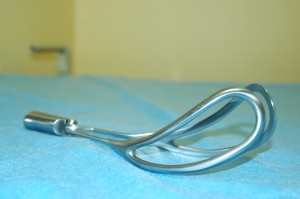Forceps Delivery
 What does forceps delivery means?
What does forceps delivery means?
Forceps are a pair of long curved tong-like device that has been used for 400 years to assist laboring mother to deliver their babies.Forceps are used in a small percentage of deliveries and is safe if used correctly by experienced practitioner
Forceps are used during the second stage of labour when the cervix is fully dilated. This instrument is considered when a laboring mother is exhausted, or if she has a medical condition (e.g. heart disease or high blood pressure) whereby shortening of second stage of labour is of benefit to her. Sometimes, forceps are used when the baby is showing signs of distress and need to be delivered in a hurry. When a baby is in a position that makes it more difficult for the laboring mother to push the baby out, then forceps may be indicated to rotate the baby’s head (certain forceps are specially designed for this function)
The laboring mother’s bladder has to be completed empty, the water bag has to be ruptured before the forceps are used. Your practitioner will numb you with a local anaesthetic unless you already have an epidural in place. You may receive an episiotomy to enlarge the vaginal opening to facilitate the delivery. Sometimes when forceps delivery is not successful, your practitioner may have to resort to emergency Caesarean section to deliver your baby
What are the advantages of forceps delivery?
You may be able to avoid a Caesarean section and problems associated with Caesarean section
What are the disadvantages of forceps delivery?
• It is less natural
• The woman is more likely to need stitches for a vaginal tear or an episiotomy
• Increased risk of damage to the muscle surrounding the anus (back passage)
• Bruises to the baby’s scalp/ face, which will fade within days
RECOMMENDED BOOK / PRODUCTS:
[easyazon-image align=”none” asin=”B004E597Q0″ locale=”us” height=”160″ src=”http://ecx.images-amazon.com/images/I/41fJNgbScSL._SL160_.jpg” width=”113″] [easyazon-image align=”none” asin=”B003EMNSIW” locale=”us” height=”160″ src=”http://ecx.images-amazon.com/images/I/51klgh0jOrL._SL160_.jpg” width=”106″] [easyazon-image align=”none” asin=”0312270232″ locale=”us” height=”160″ src=”http://ecx.images-amazon.com/images/I/41DEpTeHQrL._SL160_.jpg” width=”107″]
REFERENCES:
1. Operative Vaginal Delivery. Royal College of Obstetricians and Gynaecologists, UK. The Green-top GuidelineNo.26







